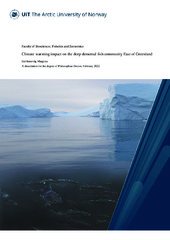| dc.contributor.advisor | Primicerio, Raul | |
| dc.contributor.author | Emblemsvåg, Margrete | |
| dc.date.accessioned | 2022-03-15T11:04:03Z | |
| dc.date.available | 2022-03-15T11:04:03Z | |
| dc.date.issued | 2022-04-06 | |
| dc.description.abstract | This thesis presents a study of the impact of climate warming on deep demersal fish communities East of Greenland, in a transition zone between Atlantic and Arctic waters. Climate change was expected to affect fish community composition and functional characterization via poleward distributional shifts and changes in abundance. To assess the climate driven effects on fish communities, I used long term survey data (1998 – 2016) covering a depth range of nearly 1500m. Data on taxonomic composition and abundance were combined with functional traits information to address temporal changes in diversity, community structure and functional characterization at different depths.
The rapid warming registered during the study period was associated with a decline in both taxonomic and functional diversity, with the sharpest negative trends at depths between 300 and 1000m. Overall, the abundance of boreal species with a generalist diet, like greater argentine (Argentina silus) and Tusk (Brosme brosme) increased, whereas the abundance of Arctic fish benthivores like Lycodes spp. and northern wolffish (Anarhichas denticulatus) decreased. Functional reorganization was most pronounced at depths from 300 to 750m. Species living at great depths down to 1000m were affected by climate events detected at the surface, displaying rapid responses that were likely mediated by behaviour. These findings suggest that deep sea demersal species can respond just as fast to environmental change as species living in the shallower waters of shelf seas. The diversity loss was not consistent with the general expectations of a climate driven increase in Arctic marine biodiversity, observed in other high latitude ecosystems. Clearly, regional conditions may decide the climate driven effects on diversity, as the combination of currents and topography East of Greenland seems to inhibit colonization by boreal species. The documented taxonomic and functional reorganization of the fish communities east of Greenland are likely to affect ecosystem functioning and vulnerability. The increasing importance of generalist species, also feeding in the pelagic food web compartment, changes the main pathways of energy and material flow, and tends to connect more tightly the food web. The increased connectivity of the food web may promote the spread of perturbations within an ecosystem that is losing adaptive capacity due to a decline in diversity. Since the East Greenland Ecosystem seems to be highly vulnerable to environmental change, future monitoring and a precautionary approach to fisheries and ecosystem management is suggested. | en_US |
| dc.description.doctoraltype | ph.d. | en_US |
| dc.description.popularabstract | This thesis presents new knowledge on major changes in deep demersal fish communities East of Greenland. Taxonomic and functional diversity declined with sharpest negative trends in depths between 300 and 1000m depth. The decrease in diversity was mainly caused by an overall loss of arctic and benthivore specialists and an increasing dominance of boreal generalists. Functional restructuring was most pronounced in in the depths between 350 – 750 m between 2005 and 2010. The surprising negative trends may be explained by regional oceanography and topography inhibiting the distribution of species. Annual fluctuations in fish abundances were highly correlated to surface climate indices (Atlantification). Such rapid ecological responses can only be mediated by behavior. These findings contradict an expected delayed response in the deep-sea and show that climate driven responses can be just as fast or faster than in shallower waters of shelf seas. The loss in taxonomic and functional diversity and the borelization of deep fish communities alters species interactions and affects ecosystem function. | en_US |
| dc.description.sponsorship | Norwegian Ministry of foreign Affairs (CLIMA project, reference RER 15/0008)
Nordic Council of ministers | en_US |
| dc.identifier.isbn | 978-82-8266-212-3 | |
| dc.identifier.uri | https://hdl.handle.net/10037/24408 | |
| dc.language.iso | eng | en_US |
| dc.publisher | UiT The Arctic University of Norway | en_US |
| dc.publisher | UiT Norges arktiske universitet | en_US |
| dc.relation.haspart | <p>Paper I: Emblemsvåg, M., Núñez-Riboni, I., Christensen, H.T., Nogueira, A., Gundersen, A. & Primicerio, R. (2020). Increasing temperatures, diversity loss and reorganization of deep-sea fish communities east of Greenland. <i>Marine Ecology Progress Series, 654</i>, 127-141. Also available in Munin at <a href=https://hdl.handle.net/10037/20298>https://hdl.handle.net/10037/20298</a>.
<p>Paper II: Emblemsvåg, M., Werner, K.M., Núñez-Riboni, I., Frelat, R., Torp Christensen, H., Fock, H.O. & Primicerio, R. Deep demersal fish communities respond rapidly to warming in a frontal region between Arctic and Atlantic waters. (Accepted manuscript). Now published in <i>Global Change Biology</i>, 2022, available at <a href=https://doi.org/10.1111/gcb.16113>https://doi.org/10.1111/gcb.16113</a>.
<p>Paper III: Emblemsvåg, M., Pecuchet, L., Velle, L.G., Nogueira, A. & Primicerio, R. Functional borealization and diversity loss in East Greenland fish communities during recent warming. (Accepted manuscript). To be published in <i>Diversity & Distributions</i>. | en_US |
| dc.rights.accessRights | openAccess | en_US |
| dc.rights.holder | Copyright 2022 The Author(s) | |
| dc.rights.uri | https://creativecommons.org/licenses/by-nc-sa/4.0 | en_US |
| dc.rights | Attribution-NonCommercial-ShareAlike 4.0 International (CC BY-NC-SA 4.0) | en_US |
| dc.subject | VDP::Matematikk og Naturvitenskap: 400::Zoologiske og botaniske fag: 480::Økologi: 488 | en_US |
| dc.subject | VDP::Mathematics and natural science: 400::Zoology and botany: 480::Ecology: 488 | en_US |
| dc.subject | VDP::Matematikk og Naturvitenskap: 400::Zoologiske og botaniske fag: 480::Marinbiologi: 497 | en_US |
| dc.subject | VDP::Mathematics and natural science: 400::Zoology and botany: 480::Marine biology: 497 | en_US |
| dc.title | Climate warming impact on the deep demersal fish community East of Greenland | en_US |
| dc.type | Doctoral thesis | en_US |
| dc.type | Doktorgradsavhandling | en_US |


 English
English norsk
norsk
